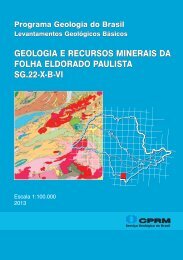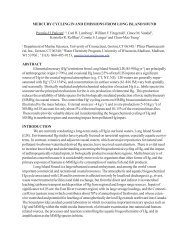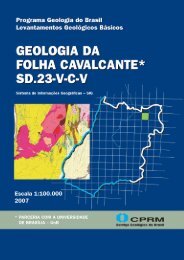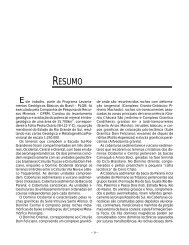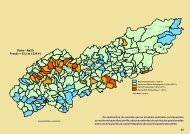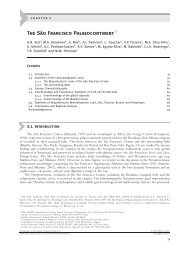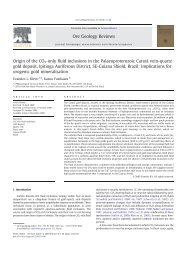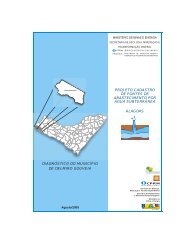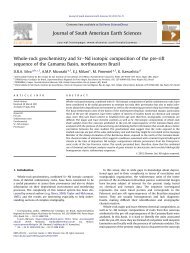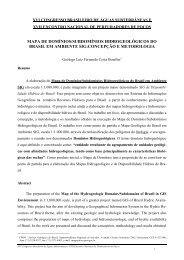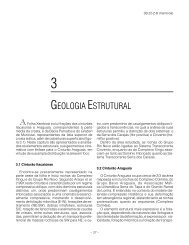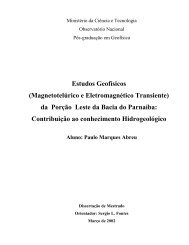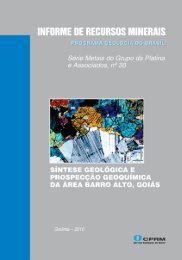Fabrics of pre- and syntectonic granite plutons and ... - CPRM
Fabrics of pre- and syntectonic granite plutons and ... - CPRM
Fabrics of pre- and syntectonic granite plutons and ... - CPRM
You also want an ePaper? Increase the reach of your titles
YUMPU automatically turns print PDFs into web optimized ePapers that Google loves.
Jabre cross-section<br />
#60<br />
#80<br />
oriented block<br />
natural outcrop<br />
#50<br />
5 km<br />
pluton, on the other h<strong>and</strong>, shows fabric orientations consistent<br />
with the host regional strain field, <strong>and</strong> is considered<br />
<strong>syntectonic</strong>.<br />
Internal discordant or concordant fabrics in the Teixeira<br />
batholith are related to the external wall-rock structure. There<br />
are steeply dipping foliations parallel to the batholith margins<br />
with subhorizontal (D1) or, particularly along its northern margin,<br />
steeply plunging (D2) lineations. Both D1 <strong>and</strong> D2 structures<br />
are attributed to a trans<strong>pre</strong>ssive regional deformation<br />
that combined simple shear <strong>and</strong> a bulk N- to NW-shortening.<br />
The vergence <strong>of</strong> asymmetric D2 folds formed during rightlateral<br />
movement <strong>of</strong> the Patos shear zone, squeezing <strong>and</strong><br />
displacing ‘‘s<strong>of</strong>t’’ metasediments against the ‘‘hard’’ hanging-wall<br />
(batholith). This implies that the batholith was<br />
entirely crystallized when the shear zone system was active,<br />
as illustrated in the Pedra D’Agua domain (Fig. 4). There,<br />
the connection between Patos, Itapetim <strong>and</strong> Taperoá shear<br />
zones develops a typical asymmetric extensional structure,<br />
with the Itapetim <strong>and</strong> Taperoá branches corresponding to the<br />
NE-trending shear b<strong>and</strong> components, while the E-trending Patos<br />
branch corresponds to the C-plane shear component. The<br />
C.J. Archanjo et al. / Journal <strong>of</strong> Structural Geology 30 (2008) 310e326<br />
#70 #30<br />
Tensor<br />
maximum (lineation)<br />
intermediate<br />
minimum (foliation pole)<br />
#40<br />
AMS<br />
lineation<br />
foliation trajectory<br />
foliation dip < 20°<br />
N<br />
txx1<br />
Teixeira cross-section<br />
Fig. 11. Shape <strong>pre</strong>ferred orientation <strong>of</strong> mafic mineral in cross sections <strong>of</strong> the Jabre <strong>and</strong> Teixeira domains. Solid symbols are for the ‘‘full ellipsoid’’, i.e. that<br />
described by the tensor principal directions resulting from the combination <strong>of</strong> all data on each <strong>of</strong> the three mutually orthogonal sections. The cone projections<br />
(1.5s) enclose the distribution <strong>of</strong> 64 (¼ 4 3 ) ‘‘subset ellipsoids’’ found after dividing the counting windows in four sub-images <strong>and</strong> combining them in each section<br />
(cf. Launeau <strong>and</strong> Robin, 2005). Arrow points the mean direction <strong>of</strong> the mineral lineation. Schmidt stereogram, lower hemisphere.<br />
PG<br />
shear b<strong>and</strong>s turn progressively to merge further north with<br />
the Patos mylonites. The sigma-shaped sheets <strong>of</strong> Pedra<br />
D’Agua <strong>granite</strong> between the Itapetim <strong>and</strong> Taperoá shear zones<br />
are entirely foliated with a fabric similar to the host orthogneisses.<br />
Shear deformation decreases towards the S~ao<br />
Sebasti~ao, Teixeira <strong>and</strong> Jabre domains as shortening is<br />
accommodated by a set <strong>of</strong> conjugate fractures <strong>and</strong> fault zones.<br />
Locally, as in the Tendó fracture zone, a strong comminution<br />
<strong>of</strong> the equigranular <strong>granite</strong> forms narrow <strong>and</strong> discontinuous<br />
b<strong>and</strong>s <strong>of</strong> mylonite <strong>and</strong> ultramylonite together with intense<br />
fracturing. Far from these domains, however, the <strong>granite</strong> fabric<br />
is medium-grained equigranular.<br />
A magmatic fabric <strong>pre</strong>dating shear zone deformation<br />
occurs in the inner parts <strong>of</strong> the Teixeira batholith. AMS is<br />
characterized by gently dipping foliations locally forming<br />
basin (Jabre) <strong>and</strong> dome (Teixeira) structures, <strong>and</strong> by lineations<br />
trending N- or NW (Figs. 10 <strong>and</strong> 11). Mean susceptibility<br />
values <strong>of</strong> 0.25 mSI contrast with the ‘‘batholith-concordant’’<br />
magnetic fabric, in which mean susceptibility is higher than<br />
1 mSI. The ‘‘batholith-discordant’’ magnetic fabric would<br />
have been acquired during the magma crystallization at about<br />
#10<br />
323



